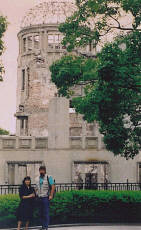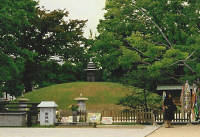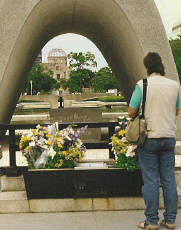Hiroshima Odyssey
Hiroshima Peace Park, Japan


A bomb dome.
![]()
![]()
Stepping off the bullet train into a cold Hiroshima morning, we could sense the past. Exactly six months earlier, my wife Irene and I became immersed in history quite by chance. A driving trip through New Mexico found us on the road to Los Alamos. We thought it might be closed to the public, and did not know about the nuclear museum until we arrived. An entire day was spent touring offices and laboratories that half a century before, had been the most secret place on earth. Robert Oppenheimer was the director of the “Manhattan Project” and producer of the first nuclear bomb. We sat at his desk and viewed drawings of that bomb. Having seen where it all began, we felt compelled to continue where it led.
We had traveled in Japan before and were familiar with the customs. While always friendly to our face, we had a sense of never being truly accepted by the Japanese. Rather than be offended by this, we accepted it as the cultural heritage of a nation that had only opened its borders to the world this past century. Our concern was running into outright hostility in a city we had blown to smithereens only a generation ago.
This anxiety was unfounded. Walking through the terminal we stood out as the only occidentals around. As we passed them, people begin bowing, and pointing towards an exit. Many of them said, “Peace Park.”


Burial Mound of blast victims.
![]()
![]()
Outside, we were directed to an electric trolley, and once onboard, received more bows, usually with a smile, and the murmur of “Peace Park.” In Hiroshima, it is assumed that all Anglos are headed for this destination. Many people waved as we trollied through the city. Fifteen minutes later we stopped next to a sight frozen in my memory.
In July of 1945, the first bomb was detonated in the New Mexico desert. On August 6, an American B29 bomber named Enola Gay dropped the second over Hiroshima, detonating at1500 feet. In the flash and fireball that followed, a two square-mile area was vaporized. Beyond that, windstorms created by the blast destroyed the rest of the city. Everything was decimated, except a concrete building directly below the bomb, The Prefecture Industrial Promotion Hall. For some reason this building, with its twisted steel dome, remained untouched and survives intact today. I knew it from countless photos. We were standing at ground zero.
Today a large green park covers the area. It is full of monuments and statues. We spent hours in the memorial museum, watching videos of survivor’s stories, and viewing displays of the destruction on that day.


Children’s Memorial.
![]()
![]()
No one in the building had a dry eye, and strangers hugged each other at random. Generations of a family stood in front of a diorama, openly crying. A hallway was lined with display cases full of hundreds of watches. All of them were frozen at 8:15 am, when the electromagnetic shock wave from the bomb stopped them forever. One room contained only slabs of old sidewalk. The heat from the blast was so intense, people’s shadows were burned into the concrete. A two-ton steel door stands twisted and mashed like an old beer can.
Hundreds of school children were in the park on a field trip. Many of them came up to us to shake hands. Many wanted to touch my beard, a rare sight in Japan. At six-foot-two with a full beard, I was obviously an American. As far as I could tell, my wife and I were the only Americans there that day among thousands of Japanese. All of them were kind and polite to us.
Outside the museum, people motioned for us to follow them. We passed a shrine with a flame burning inside. A plaque said the flame would be extinguished when the final nuclear weapon in the world is destroyed. Next we came to a small futuristic pagoda surrounded by lotus blossoms. Inside was a large bell. We heard its deep melodious tones throughout the day. People lined up to swing a large log and strike the bell. A bent old man took my hand, leading me toward the bell. He was old enough to be a survivor, but I did not ask.
Together, Irene and I swung the log, and a beautiful tone floated from the bell over the park. The old man told us, whenever the bell is struck, prayers for the victims’s souls fly skyward.
We passed a second large grassy mound. It is the burial site of 100,000 Japanese who died that day. The trees surrounding the mound were covered with brightly covered origami birds, sent to the park from schoolchildren around the world. After the blast, schoolchildren, mobilized by the army, collected these bodies for burial. There were not enough adults alive to do the job.


Eternal Flame Memorial.
![]()
![]()
There is a second, much smaller mound just outside the park boundary. This is the grave-site of all the Koreans who died in the blast. Because of long-held animosities between the two countries, they were not allowed burial within the park itself.
We stopped to take a photo, and four young schoolgirls in blue and white uniforms approached us. They wanted their photos taken with me, and each handed Irene their Instamatics. They crowded around me, and just before the picture was snapped, each of them raised a hand to give the peace sign.
Our journey, begun in the New Mexican desert, brought us across an ocean and more than five decades. There will always be a debate over the morality of using the bomb. The facts are, on August 6, 1945, nine out of 10 victims were women and children. A second bomb was dropped on Nagasaki two days later, with similar results. Fortunately the world has been spared a repeat of this horror since that time. The Hiroshima Peace Park is a memorial, a reminder, and a warning, of what man has done, and can do again. These people will never forget what happened, but they forgave long ago.